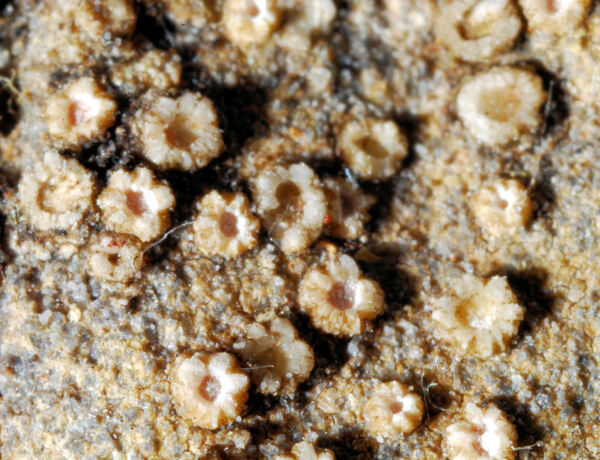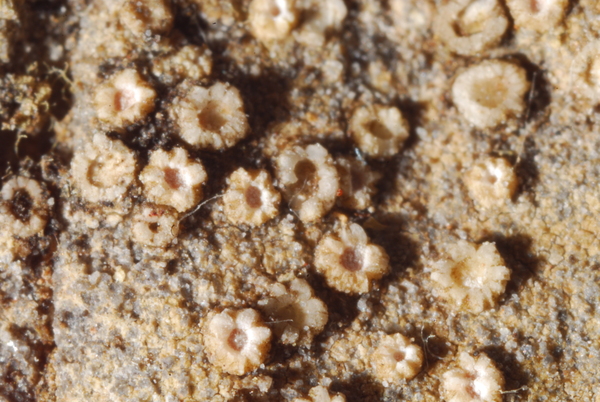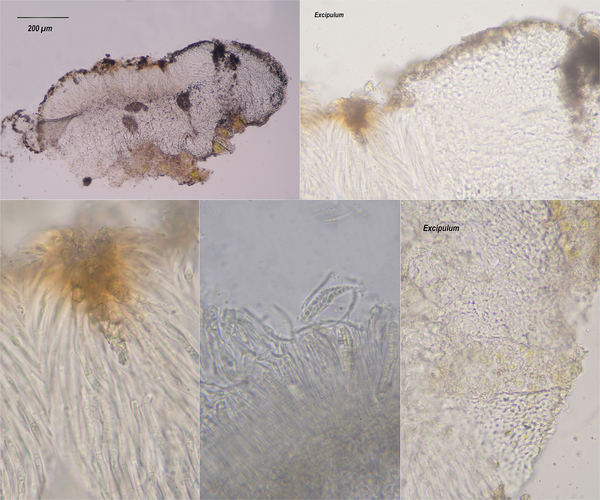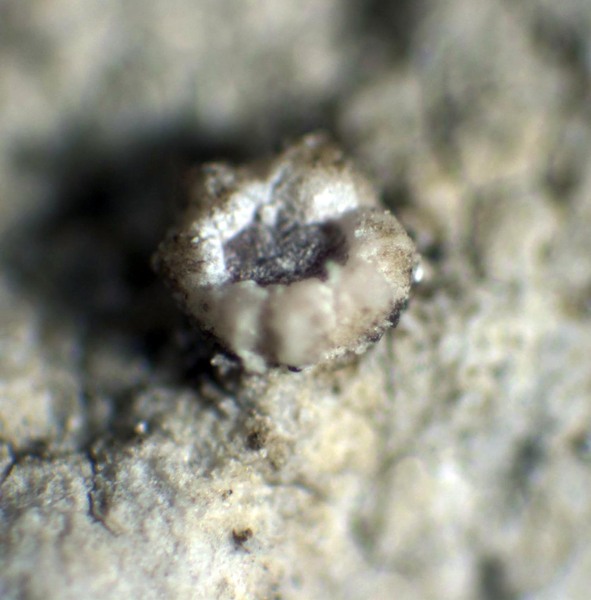Gyalecta leucaspis (A. Massal.) Kremp.
Denkschr. k. bayer. bot. Ges., 4: 168, 1861. Basionym: Secoliga leucaspis Kremp. ex A. Massal. - Atti Ist. Ven. Sc. Lett. Arti, ser. 3, 2: 370, 1856.
Synonyms: Gyalecta acicularis Anzi; Thelotrema leucaspis Kremp.
Description: Thallus crustose, thin, continuous to rimose, orange-pink to pale grey-green, turning whitish in the herbarium, forming up to 10 cm wide patches. Apothecia usually numerous, sessile, constricted at base, round, (0.3-)0.5-1(-1.2) mm across, with a pale pink-orange, at first pore-like, then concave, thickly white-pruinose disc, and a crenate or radially cracked, whitish proper margin. Proper exciple pale pink to brownish yellow in outer part, colourless within; hymenium colourless or yellowish in lower part, non- or very weakly amyloid, 70-90 µm high; paraphyses 1.5-2 µm thick, the apical cells not markedly swollen, up to 3 µm wide; hypothecium colourless. Asci 8-spored, thin-walled, lacking an apical apparatus or tholus, K/I+ blue, with uniseriately or partly biseriately arranged spores. Ascospores transversally (3-)4-9-septate, bacilliform to slightly clavate (often broader at one extremity), (25-)30-50 x 3-5(-7) µm. Photobiont trentepohlioid. Spot tests: K-, C-, KC-, P-, UV-. Chemistry: without lichen substances.
Growth form: Crustose
Substrata: rocks
Photobiont: Trentepohlia
Reproductive strategy: mainly sexual
Commonnes-rarity: (info)
Alpine belt: absent
Subalpine belt: very rare
Montane belt: rare
Dry submediterranean belt: extremely rare
Humid submediterranean belt: absent
Padanian area: absent
pH of the substrata:
1 2 3 4 5
Solar irradiation:
1 2 3 4 5
Aridity:
1 2 3 4 5
Eutrophication:
1 2 3 4 5
Poleotolerance:
0 1 2 3
Altitudinal distribution:
1 2 3 4 5 6
Rarity
absent
extremely rare
very rare
rare
rather rare
rather common
common
very common
extremely common
Loading data...
Occurrence data
Predictive map
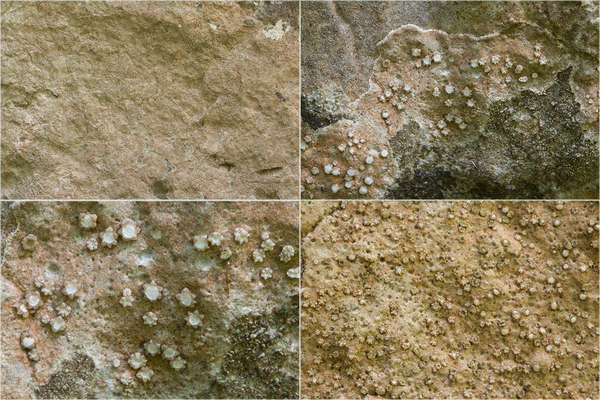
Marta González García & Enrique Rubio - Centro de Estudios Micológicos Asturianos
Spain, Aller-Asturias, Cuevas
15.07.2021
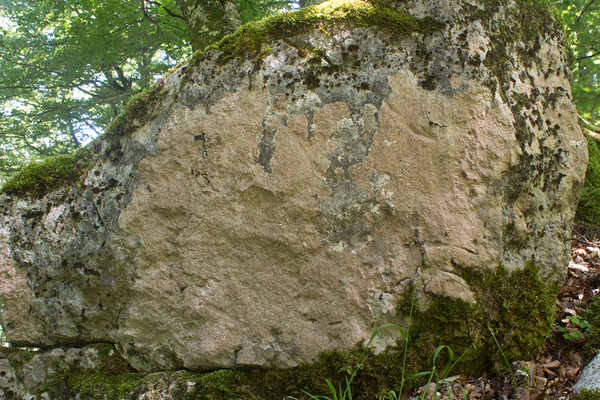
Marta González García & Enrique Rubio - Centro de Estudios Micológicos Asturianos
Spain, Aller-Asturias, Cuevas
15.07.2021
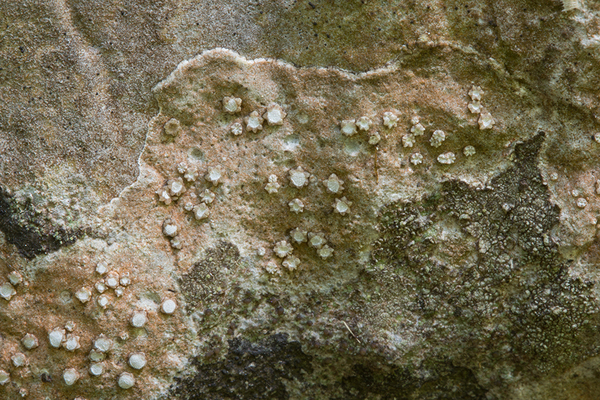
Marta González García & Enrique Rubio - Centro de Estudios Micológicos Asturianos
Spain, Aller-Asturias, Cuevas
15.07.2021
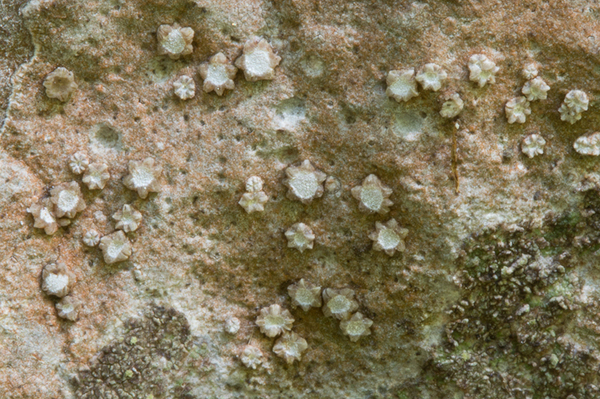
Marta González García & Enrique Rubio - Centro de Estudios Micológicos Asturianos
Spain, Aller-Asturias, Cuevas
15.07.2021
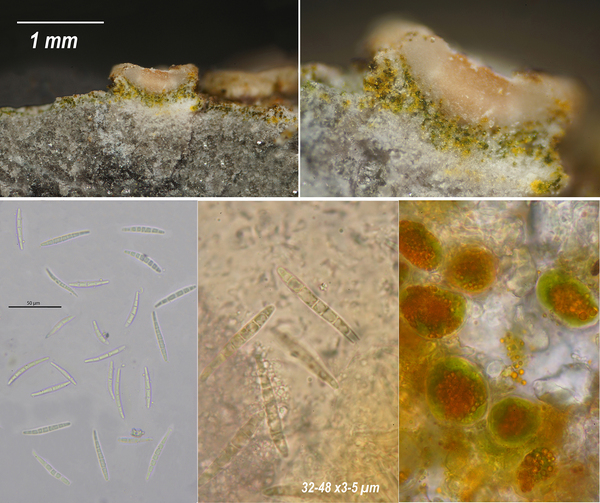
Marta González García & Enrique Rubio - Centro de Estudios Micológicos Asturianos
Spain, Aller-Asturias, Cuevas
15.07.2021
Growth form: Crustose
Substrata: rocks
Photobiont: Trentepohlia
Reproductive strategy: mainly sexual
Commonnes-rarity: (info)
Alpine belt: absent
Subalpine belt: very rare
Montane belt: rare
Dry submediterranean belt: extremely rare
Humid submediterranean belt: absent
Padanian area: absent
pH of the substrata:
| 1 | 2 | 3 | 4 | 5 |
Solar irradiation:
| 1 | 2 | 3 | 4 | 5 |
Aridity:
| 1 | 2 | 3 | 4 | 5 |
Eutrophication:
| 1 | 2 | 3 | 4 | 5 |
Poleotolerance:
| 0 | 1 | 2 | 3 |
Altitudinal distribution:
| 1 | 2 | 3 | 4 | 5 | 6 |
Rarity
absent
extremely rare
very rare
rare
rather rare
rather common
common
very common
extremely common
Loading data...
Occurrence data
Predictive map

Marta González García & Enrique Rubio - Centro de Estudios Micológicos Asturianos
Spain, Aller-Asturias, Cuevas
15.07.2021

Marta González García & Enrique Rubio - Centro de Estudios Micológicos Asturianos
Spain, Aller-Asturias, Cuevas
15.07.2021

Marta González García & Enrique Rubio - Centro de Estudios Micológicos Asturianos
Spain, Aller-Asturias, Cuevas
15.07.2021

Marta González García & Enrique Rubio - Centro de Estudios Micológicos Asturianos
Spain, Aller-Asturias, Cuevas
15.07.2021



